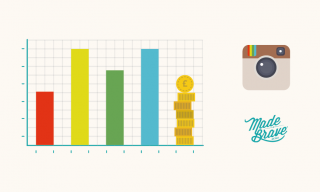As more social media channels introduce in-app shopping – what does this mean for brands and the future of ecommerce?
When we first started using social media (anyone else remember MySpace profile songs?) we didn’t quite realise how much it would play a part in how we shop (we, being the users, not those building it – we’re pretty sure they knew exactly what they were doing).
According to a study by the guys over at Salesforce, 54% of millennials use social channels to research products before they buy. Similarly, 31% of online shoppers said that they use social to browse for new items. Also, in a quick, shouting-across-the-studio survey, 80% of MadeBravers raised their hands to confirm that they look at social media to find cool products (it would’ve been 100%, but the dogs aren’t that great at typing yet).
For brands, this thinking developed into content marketing strategies that drive people to a website to buy, but now social media has developed to become a collective of ecommerce platforms in their own right. So, now what?
You might’ve recently seen a big announcement from Instagram and the launch of Instagram Checkout. Basically, Instagram Checkout allows you to upload your payment details and pay for products without having the leave the app. As they take a percentage from every sale, Deutsche Bank have estimated that it will rake in over $10 billion a year for Facebook – which is certainly enough to buy a few ice-lollies for the team every Friday.
Just last March, Instagram hinted that this sort of thing would be coming, when they launched their shop function for business pages (brands could tag products, with prices) but still, the user had to click off to shop on the brand’s website. This idea also echoed through the swipe-up function on stories. In even more news, it was rumoured last year that Instagram was developing an entirely separate shopping app. The recent Instagram Checkout launch could mean two things 1) they decided that they could just merge it all together or 2) they’re testing the demand through Instagram before they get started. Smart cookies that bunch.
Even though Instagram Checkout has recently just popped onto our feed, social shopping isn’t new for ‘Zuck and his team. In 2015, they launched the ‘Shop’ function on Facebook business pages with product catalogues. For most UK businesses, users can click through to the website or message to arrange buying the product (eg: through PayPal etc). However, in the USA, you can now shop directly through Facebook pages.
Outside of Facebook HQ, other social channels have been jumping on the social shopping wagon – some more successful than others. One one hand, Pinterest are absolutely knocking it out of the park with their ‘Shop The Look Pins’ (most likely due to the fact that it’s near impossible to not want everything on there), however Twitter’s ‘Buy It’ button folded in 2017. There’s even already a channel specifically built for social shopping called 21 Buttons, that looks sorta really similar to Instagram and allows influencers to upload photos, link through and earn from the sales they make (although, shopping through influencers has already started on Instagram).
So, with all these in-app social shopping features, what does it mean for buyer journeys?
In an ideal world, the average buyer journey would look something like this:
“Oh, I like that” > click > buy
When really, it looks more along the lines of this…
“Oh, I like that” > forgets they saw it > sees another social post “oh yeah, there’s that thing I like” > checks website 2 weeks later > needs to run for the train > sees retargeting ad “There’s that thing again” > goes to website > checks size > checks price > checks bank account > reads reviews > back on social > clicks > buys > returns for a refund 3 weeks later because it’s too big
As much as we’d like to think of online shopping as a simple transaction, it’s more like a really intense game of squash. Social shopping aims to make things a bit less back-and-forth by taking out a few stages and making it super easy to click and buy. But what does this mean for ecommerce websites? We don’t see brands shimmying over to social shopping only (especially with limited functionality in comparison to websites) but, like anything, it has its pros and cons…
For businesses, social shopping can open up more opportunities for impulse buys: There are fewer steps in the user-journey, shorter loading times and preloaded payment details that make it easier for buyers to well, buy. All of the order details are managed through social (eg: Instagram pushes notifications when the order is shipped) and there’s a huge possibility for smarter strategies around social ads (eg: will you be able to target people who have actually bought from other brands?) This could result in much stronger reporting and flip social from being a marketing tool into a lean, mean, money-making machine – which could surely convince even the toughest social media cynics. Also – for smaller brands just starting out, it’s an easier (and cheaper way) to get going, without the cost and logistics of setting up an ecommerce site. This could level the playing field and even give brands a chance to test first and adjust, before commiting to a full website of their own (fail fast and all that jazz).
But it’s not all about businesses – for users, social shopping is a shiny beacon of convenience. There are fewer steps to buy something, less time waiting for sites to load and none of that trying to remember your password from 2013 malarky that comes with buying stuff online. Depending on how many brands start to use these tools, there could come a time where we’re able to do all of our shopping in one place and even create ‘buyable wish lists’ using tools like boards on Pinterest or Instagram collections *waves goodbye to our pocket money*
As much as this all sounds peachy, there are other things to consider before diving head first into social shopping.
Remember that stat about Facebook earning $10 billion a year? That all comes from a percentage of sales – which means, as a brand, you not only have to pay to promote your products, you have to give a chunk of sales away too. There’s also the age-old phrase of “you should never put all your eggs sales in the one basket, especially a basket that can change with the switch of an algorithm” – classic wisdom, that. If you have everything on social, there’s less opportunity for people to go onto your site and potentially discover other products they’d want to buy, or y’know, just get to know your brand on its own turf. From a resource side of things – if you have a site and social shopping, that could be double the work and an inbox (even more) flooded with customer service enquiries alongside brand engagement messages – which could be difficult to manage with a small team. In saying that, brands who do use in-app social shopping could be given more visibility and reach over those who don’t.
With all this in mind, you’d think it was a sweeter deal for the users – which, it sorta is, but there are still down-sides to this rise of social shopping. First of all, it’s likely that not all brands will do it, or there will be a limited selection of products to be sold in-app, which means there’s less variety and the idea of shopping in the one place is maybe more of a daydream than a reality – damn it! There’s also a dangerous mix of one-click-shopping and less space for important product information (size guides, dimensions, care instructions etc) in comparison to websites, which could result in ordering what you think is a giant T-Rex costume for you, but it turns out to be one for your dog (still worth it, but it’s not exactly going to do for your marathon run, is it?). Also, products on social could potentially be more expensive (as they’re taking a cut) and also, it could be so easy that it just encourages you to spend all your money on stuff you don’t need – which we never do anyway *hides hoverboard*
One of the biggest questions we have about social shopping is – what effect does this have on brand? Social channels are already jam-packed with ads, will this tip it over into a sales channel once and for all? Although this is good for businesses (in some ways) there’s a fine balance between doing what’s good for profit and what’s good for brand sentiment and yep, building a community. Even though the tools are there, it’s up to brands (and if they keep that balance) to determine whether social media will still be well, social, or if we’ll all start to communicate with each other in completely new ways. Either way, social media has become a key player in how we do pretty much everything and will continue to massively shift how we interact with brands and how brands interact with us.
What are your thoughts on social shopping? Tweet us!



